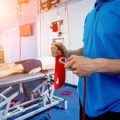1. Understanding Ergonomics in the Modern Workplace
What Is Ergonomics?
Ergonomics is the science of designing and arranging workspaces, products, and systems so they fit the people who use them. It’s all about making sure that the tools and environments we use every day support our bodies and help us stay healthy and productive. When workplaces are set up with ergonomics in mind, employees can avoid discomfort and injuries, while boosting their performance.
Why Ergonomics Matters in American Workplaces
American workplaces are more diverse than ever—ranging from office settings to factories, hospitals, retail stores, and even remote home offices. No matter the industry, good ergonomics makes a big difference. Here’s why:
- Injury Prevention: Poor ergonomics can lead to musculoskeletal disorders (MSDs) like back pain, carpal tunnel syndrome, and neck strain.
- Productivity: Comfortable workers are more focused and efficient.
- Job Satisfaction: Employees appreciate when their health and comfort are prioritized.
- Cost Savings: Fewer injuries mean less money spent on workers’ compensation and lost time.
Common Ergonomic Challenges Across Industries
Different industries face unique ergonomic issues. Here’s a quick look at some typical challenges found in American workplaces:
| Industry | Common Ergonomic Challenges |
|---|---|
| Office Work | Poor chair support, improper desk height, awkward computer placement |
| Manufacturing & Warehousing | Lifting heavy loads, repetitive motions, standing for long periods |
| Healthcare | Lifting patients, bending over beds, standing for shifts |
| Retail | Cashing out customers for hours, stocking shelves, using ladders or step stools |
| Remote/Home Offices | Lack of proper chairs or desks, poor lighting, working from couches or beds |
The Bottom Line on Ergonomics in Today’s Workplaces
No matter where you work or what you do, understanding ergonomics is key to staying healthy and productive. Paying attention to how your workspace is set up can make a big difference in your daily comfort and long-term well-being.
2. Key Principles of Ergonomic Design
Understanding Core Ergonomic Concepts
Ergonomics is about making the workplace fit the worker, not the other way around. When U.S. offices and industrial environments apply ergonomic principles, they help prevent injuries, improve comfort, and boost productivity. Lets break down some key concepts you’ll see in American workplaces.
Neutral Posture
Maintaining a neutral posture means keeping your body aligned and relaxed. This position puts the least strain on your muscles and joints. For example, when sitting at a desk, your feet should be flat on the floor, knees at about a 90-degree angle, and your back supported by your chair. Your wrists should stay straight when typing or using a mouse.
Repetitive Motion Prevention
Doing the same motion over and over—like typing or assembling parts—can lead to repetitive strain injuries (RSIs). U.S. workplaces often encourage micro-breaks, job rotation, and stretching exercises to reduce this risk. Ergonomic tools like split keyboards or anti-fatigue mats also help minimize strain.
Workstation Adjustability
No two workers are exactly alike. That’s why adjustable workstations are so important in both offices and factories across America. Features like height-adjustable desks, monitor arms, and movable chairs let everyone customize their setup for maximum comfort.
| Adjustable Feature | Why It Matters | Common Examples in U.S. Workplaces |
|---|---|---|
| Chair Height | Prevents leg discomfort and improves circulation | Office task chairs with pneumatic adjustment levers |
| Monitor Position | Reduces neck and eye strain | Monitor stands or adjustable arms |
| Desk Height | Supports good posture whether sitting or standing | Sit-stand desks (standing desks) |
| Tool Placement | Keeps tools within easy reach to avoid overreaching | Custom tool trays for assembly lines |
Layout Considerations for U.S. Offices & Industrial Settings
The layout of a workstation can make a big difference in safety and efficiency. In American offices, desks are arranged so that employees have enough personal space and clear walkways. Frequently used items—like phones or reference materials—should be within arm’s reach to cut down on unnecessary movement.
In industrial environments, work areas are organized to support smooth workflow and easy access to tools and materials. Markings on floors (using tape or paint) help define safe walkways and storage zones—a common practice in U.S. factories and warehouses.
Quick Tips for Better Ergonomics at Work
- Sit with your back supported and feet flat on the floor.
- Keep screens at eye level to avoid neck pain.
- Take short breaks every hour to stretch or move around.
- Arrange your most-used items within easy reach.
Applying these core ergonomic principles helps create safer, more comfortable workplaces across the United States—whether you’re working at a computer or on an assembly line.
![]()
3. Best Practices for Workstation Setup
Desk and Chair Arrangement
Setting up your desk and chair correctly is the foundation of good ergonomics, whether you work from home or in a traditional office. Here are some practical tips to help you get started:
| Component | Recommendation |
|---|---|
| Desk Height | Your elbows should be at a 90-degree angle when typing, with your forearms parallel to the floor. Standard desks in the U.S. are typically 28-30 inches high, but adjustable desks are becoming more popular for flexibility. |
| Chair Support | Choose a chair with adjustable height, lumbar support, and a seat that lets your feet rest flat on the floor. If your feet dont reach, use a footrest. |
| Armrests | Adjust armrests so your shoulders stay relaxed and your arms rest gently, avoiding shoulder hunching. |
Monitor Placement
Your monitor setup can significantly impact your posture and comfort throughout the day. Follow these best practices:
- Height: The top of your screen should be at or just below eye level so you can look straight ahead without bending your neck.
- Distance: Keep the monitor about an arm’s length away—roughly 20 to 30 inches—from where you sit.
- Glare Reduction: Position the monitor perpendicular to windows or use blinds to reduce glare. Consider anti-glare screen protectors if needed.
Peripheral Devices: Keyboard & Mouse
Proper placement of your keyboard and mouse helps prevent wrist strain and repetitive stress injuries:
- Keyboard: Place it directly in front of you, keeping wrists straight and hands at or slightly below elbow level. Consider using a keyboard tray for better alignment.
- Mouse: Keep it close to your keyboard; avoid stretching or reaching. A mouse pad with wrist support can add extra comfort.
Quick Reference Table: Key Ergonomic Measurements
| Item | Ideal Position/Measurement |
|---|---|
| Sitting Eye Level to Monitor Top | Straight ahead or slightly downward (about 2-3 inches below eye level) |
| Chair Height | Feet flat on floor, knees at hip level or slightly lower (usually 16-21 inches off the ground) |
| Monitor Distance from Eyes | 20-30 inches (arms length) |
| Keyboard Height | Straight wrists, forearms parallel to floor (typically desk height or slightly lower with a tray) |
| Elbow Angle While Typing | Around 90 degrees |
Remote vs. In-Office Setups: Popular Options in the U.S.
In-Office Setups
- Sit-Stand Desks: Many American offices now offer adjustable-height desks so employees can switch between sitting and standing during the day.
- Cubicles/Open Spaces: Ensure privacy screens don’t block airflow or access to natural light where possible.
- Cable Management: Use cable trays or clips to keep cords organized and out of foot traffic areas.
- Lumbar Cushions: If your office chair lacks built-in support, add a cushion for lower back comfort.
Remote/Home Office Setups
- Laptop Stand & External Keyboard/Mouse: Elevate your laptop screen to eye level and use external devices for better ergonomics.
- Kitchens & Dining Tables: If working from non-traditional spaces, use seat cushions or stack books under monitors to achieve correct heights.
- No Dedicated Desk? Portable lap desks or folding tables are popular solutions for small apartments or shared spaces.
- Cordless Accessories: Wireless keyboards and mice reduce clutter and allow flexible arrangement.
- Create Boundaries: Use room dividers or noise-canceling headphones to carve out focus zones if you share space with others.
Troubleshooting Common Problems
| Pain Point/Issue | Quick Fixes/Tips |
|---|---|
| Sore Neck/Shoulders | Raise monitor; check chair height; take frequent stretch breaks |
| Numb Hands/Wrists | Add wrist support; reposition keyboard/mouse; check elbow angle |
| Tired Eyes | Blink often; follow the “20-20-20” rule (every 20 minutes, look at something 20 feet away for 20 seconds); adjust brightness/contrast |
| Sore Lower Back | Add lumbar cushion; ensure feet are flat on floor; get up and move every hour |
The right ergonomic workstation can make a huge difference in how you feel during and after work hours. With these best practices, you can create a comfortable, productive environment whether youre working remotely or in an office setting.
4. Preventing Workplace Injuries: Tips and Strategies
Understanding Musculoskeletal Disorders (MSDs)
Musculoskeletal disorders (MSDs) are among the most common workplace injuries in the United States. These injuries often affect muscles, tendons, ligaments, nerves, and joints, usually caused by repetitive motions, awkward postures, or staying in one position for too long. Preventing MSDs is a key focus of workplace ergonomics.
Essential Tips to Avoid Workplace Injuries
1. Take Regular Movement Breaks
Sitting or standing in the same position for hours can strain your body. American organizations encourage employees to take short breaks every 30 to 60 minutes. Get up, walk around, and stretch lightly to keep your muscles flexible and reduce fatigue.
2. Incorporate Stretching Routines
Stretching helps maintain flexibility and reduces muscle tension. Many U.S. companies share quick stretching routines employees can do at their desks or workstations. Here is a simple routine you can follow:
| Stretch | How To Do It | Duration |
|---|---|---|
| Neck Stretch | Tilt your head gently from side to side | 10 seconds each side |
| Shoulder Rolls | Roll shoulders forward and backward | 10 times each direction |
| Wrist Stretch | Extend arm, pull fingers back gently with other hand | 10 seconds each hand |
| Seated Torso Twist | Sit upright, twist upper body gently left and right | 10 seconds each side |
| Ankle Circles | Lift feet off floor, rotate ankles in circles | 10 times each direction |
3. Promote a Culture of Safety and Wellness
Cultivating a culture where safety and wellness are valued is essential in American workplaces. Encourage open communication about ergonomic concerns. Many U.S. companies provide wellness programs that include ergonomic training, fitness classes, or incentives for healthy habits. Involve everyone—from management to staff—in identifying risks and finding solutions.
Create Supportive Work Environments
A supportive environment includes adjustable furniture, proper lighting, and easy access to ergonomic tools like footrests or sit-stand desks. Empower employees to personalize their workstations for comfort and efficiency.
Encourage Reporting and Feedback
A proactive approach involves encouraging employees to report discomfort early and give feedback on workplace design. This allows organizations to make timely improvements and prevent minor issues from becoming serious injuries.
The American Approach: Teamwork Matters!
The U.S. emphasizes teamwork and shared responsibility when it comes to workplace health and safety. By working together—sharing tips, supporting movement breaks, participating in wellness programs—everyone helps create a safer, healthier work environment.
5. Implementing and Sustaining Ergonomic Programs
Launching Effective Ergonomic Initiatives
Getting started with workplace ergonomics doesn’t have to be complicated. The first step is to form a team that includes employees, managers, and safety professionals. This group will help identify problem areas, set goals, and keep everyone on track. Begin by assessing current workstations and processes to spot risks or discomforts.
Step-by-Step Guide for Launching Ergonomics Programs
| Step | Description |
|---|---|
| 1. Form a team | Include employees from different departments and levels for better input. |
| 2. Assess current situation | Observe workstations, gather employee feedback, and review injury reports. |
| 3. Set clear goals | Decide what you want to improve (e.g., reduce back pain, fewer repetitive injuries). |
| 4. Develop solutions | Create simple fixes like adjusting chair heights or bigger changes like purchasing ergonomic equipment. |
| 5. Roll out changes | Implement solutions in phases and communicate clearly with all staff members. |
| 6. Monitor and adjust | Track progress, collect feedback, and tweak the program as needed. |
Employee Training and Engagement
Training is crucial for the success of any ergonomic initiative. Employees should learn how to properly set up their workstations, use equipment correctly, and recognize early signs of discomfort. Hands-on demonstrations, short videos, or online modules can make learning easy and accessible for everyone.
Tips for Effective Ergonomics Training:
- Keep sessions interactive—let people ask questions and try things themselves.
- Use real-life examples from your own workplace.
- Offer refresher courses regularly to reinforce good habits.
- Encourage employees to report concerns early for quick adjustments.
Ongoing Assessment and Continuous Improvement
Sustaining ergonomic improvements means checking in regularly. Schedule routine workstation reviews and collect employee feedback through surveys or suggestion boxes. Track injury rates and absenteeism linked to musculoskeletal issues—this helps measure progress over time. Be open to trying new tools or rearranging spaces as needs change.
Leveraging U.S. Resources: OSHA Guidelines & Wellness Programs
The Occupational Safety and Health Administration (OSHA) offers detailed guidelines for setting up safe workplaces, including ergonomics checklists for various industries. Many American companies also tie ergonomics into broader workplace wellness programs, offering incentives for participation or providing free ergonomic equipment assessments.
Helpful U.S. Resources for Workplace Ergonomics:
| Resource | Description/Link |
|---|---|
| OSHA Ergonomics eTool | https://www.osha.gov/ergonomics |
| CDC NIOSH Ergonomics Program | https://www.cdc.gov/niosh/topics/ergonomics/ |
| Workplace Wellness Programs | Check with your HR department or local health agencies for resources on wellness incentives tied to ergonomics. |
By following these steps and using trusted resources, businesses can create comfortable, healthy work environments where employees feel valued—and everyone benefits from fewer injuries and improved productivity.


